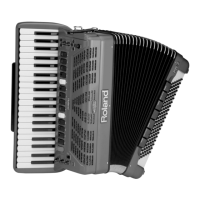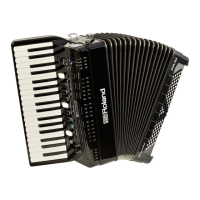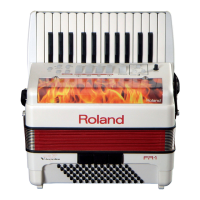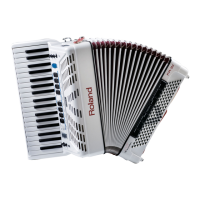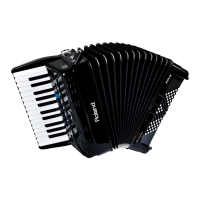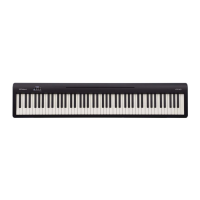Selecting Parameters
85
Samples (PCM waveforms), on the other hand, can lower the pitch
of a recorded sound almost indenitely. But that doesn’t sound
very natural. The “Lowest Note” parameter allows you to specify the
lowest pitch the sample can use. If you nevertheless play a lower
note on the bass keyboard, it will be sounded one octave above the
corresponding pitch and sound natural. Here is an example:
If this is what you play on the bass keyboard…
…after choosing... Lowest Note = E
…these notes are transposed 1 octave up
The Orchestra Bass sound thus changes octaves. For some songs,
the default setting (E) may yield odd results, especially if you need
to play walking bass lines, etc. In that case, you can change the
“Lowest Note” setting to achieve a satisfactory result.
Parameter Value Explanation
OCTAVE –3~0~+3
This parameter allows you to transpose the
Orchestra Bass section (i.e. the selected orchestral
or organ sound) up or down.
Use it if the part you want to play with the bass
buttons is too low or too high for what you have
in mind.
VOLUME
O,
–40~“Std”~40
This parameter allows you to set the level of the
Orchestra Bass part
PANPOT
63 Bass~0~63
Treble
Depending on the selected sound, this parameter
allows you to change the Orchestra Bass part’s
placement in the stereo sound eld (i.e. between
the left and right speakers) to create a livelier
sound image.
The “Treb” values mean that the sound will appear
on the same side as the Right Hand (treble)
accordion sound. This setting applies to both the
FR-8x’s internal speakers and the L/MONO socket.
The “Bass” values mean that the sound will appear
on the same side as the bass accordion sound
(which is not available while an Orchestra Bass
sound is being used). This setting applies to both
the FR-8x’s internal speakers and the R/MONO
socket.
Choose “0” if the Orchestra Bass sound should be
at the center of the stereo image.
8.3 Eects Send
This page allows you to set various eects.
Parameter Value Explanation
REVERB
0~127
Use these parameters to set the Reverb,
Chorus or Delay send levels (how
much eect should be applied to the
Orchestra Bass section).
CHORUS
DELAY
8.3 VTW Pedal Parameter (only for VTW Organ
Tone)
This page allows you to make additional detailed
settings for the Organ sound.
NOTE
The organ eects described below apply to all sections that use
VTW Organ sound.
Vibrato/Chorus
The vibrato eect cyclically modulates the pitch of organ sounds
(which is dierent from the Rotary eect).
Parameter Value Explanation
Vib/Cho Switch O, On
You can apply vibrato or chorus to the
organ sound.
Vib/Cho Type
V-1, V-2, V-3
C-1, C-2, C-3
The eect will intensify as the vibrato
type (V-1, V-2, V-3) or chorus type (C-1,
C-2, C-3) moves to a higher number
Vib/Cho Vintage ‘50, ‘60, ‘70
Tonewheel used in tonewheel organs of
1950, 1960, 1970.
Vib/Cho Level 0~127
Use this parameter to set the Vibrato or
chorus level.
Overdrive
This eect distorts the sound, giving it an “edge” and making it
suitable for hard rock and similar musical genres. See also the
“NOTE” under “Vibrato/Chorus”.
Parameter Value Explanation
Overdrive Switch O, On
Allows you to switch the overdrive eect
on or o.
Overdrive Drive 0~127
Species how strongly the sound is
distorted. A value toward 127 raise the
gain, adding distortion to the sound.
Overdrive Level 0~127
Species the level of the eect with
respect to the unprocessed organ signal.
Rotary
The eect in this section simulates the typical sound modulation
generated by a cabinet with rotating loudspeakers.
Most functions (start/stop, rotation speed selection, etc.), need to
be selected with an optional MIDI foot controller (e.g. FC-300) ( p.
106), Chin Switches ( p. 98) or Function Switches ( p. 106).
Parameter Value Explanation
Leakage Level 0~127
Species the level of the eect with
respect to the unprocessed organ signal.
Rotary Snd Level 0~127 You can adjust the level of rotary eect.
Rotary Snd
Reverb
0~127
Allows yo to specify the level of the
rotary signal that is transmitted to the
reverb eect.
Choose “0” if the sound should not be
processed by the organ reverb processor.

